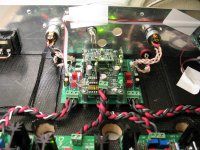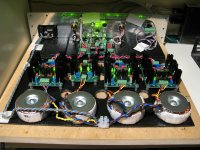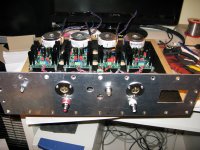I am sure many of you will be interested in this:
http://www.diyaudio.com/forums/twisted-pear/183663-legato-3-look-ma-no-caps.html
Cheers!
Russ
http://www.diyaudio.com/forums/twisted-pear/183663-legato-3-look-ma-no-caps.html
Cheers!
Russ
Hi Russ , the low pass filter of Sabre is working? If yes, wich frequency and order?
Thanks
The normal oversampling digital filter is used by default. You can find info about it in the ES9018 datasheet.
Why do you need four transfomers and dual placid regulators?
He does not strictly *need* them, but it looks to me like he is powering each section of the legato separately which is an option.
Hi, I'd like to share my success story. 🙂
I just got my BII finished and hooked up.
It's a BII + Placid + Volumite + Toslink kit with Lundahl LL1588 transformers on the output.
I haven't had the chance to sit down and make a serious comparison but so far I like it. 😀
Very smooth, detailed and with lots of air. It's just music playing effortlessly and relaxed.
I just got my BII finished and hooked up.
It's a BII + Placid + Volumite + Toslink kit with Lundahl LL1588 transformers on the output.
I haven't had the chance to sit down and make a serious comparison but so far I like it. 😀
Very smooth, detailed and with lots of air. It's just music playing effortlessly and relaxed.
Attachments
Are you running a Placid in that, to my eyes, closed enclosure ?
Keep track at the heat dissipation.
Keep track at the heat dissipation.
Thanks for the heads up. 🙂
It's all aluminum with built in heat sinks but I'll keep an eye on the temp.
It's all aluminum with built in heat sinks but I'll keep an eye on the temp.
Why do you need four transfomers and dual placid regulators?
is this Q ment for me?
Hi, I don't know if this question should be put her but here it goes. Is it possible to know which are the IC's used in the buffalo on-board regulators?
Thanks!
Thanks!
Would this be an appropriate tube I/V stage?
Would this Welborne tube output stage work well with the buffalo II?
Are the raw DAC outputs available directly from the DAC chip? Or are there op amps between the DACs raw output and the analog I/V output coming from the board?
DAC Tube Output Stage Kit
Would this Welborne tube output stage work well with the buffalo II?
Are the raw DAC outputs available directly from the DAC chip? Or are there op amps between the DACs raw output and the analog I/V output coming from the board?
DAC Tube Output Stage Kit
Would this Welborne tube output stage work well with the buffalo II?
Are the raw DAC outputs available directly from the DAC chip? Or are there op amps between the DACs raw output and the analog I/V output coming from the board?
DAC Tube Output Stage Kit
It seems that such tube output stage may work as an active current to voltage stage, but then you will loose one half of the differential current output. I believe it is not the best option.
It seems also that such tube output stage may work as a passive current to voltage stage, but then you will have 9018 at voltage mode. I believe it is not the best option also.
If I said something wrong, more experienced diy'ers are free to rectify any mistake.
Would someone tell me, please, what is the 9018 current output in mA (p-p) at full scale (0dBfs)?
Thank you.
Thank you.
Thank you for your replies.
What would be a good option for a tube output stage for use with the Buffalo II?
Is there something where there is a P.C. board available?
I saw these tube-i-zator boards being discussed in another thread. Would that be a better choice?
http://www.diyaudio.com/forums/group-buys/156149-tube-i-zator-professional-pcb.html
What would be a good option for a tube output stage for use with the Buffalo II?
Is there something where there is a P.C. board available?
I saw these tube-i-zator boards being discussed in another thread. Would that be a better choice?
http://www.diyaudio.com/forums/group-buys/156149-tube-i-zator-professional-pcb.html
In this case, a maximum level of raw output can be changed to some extent by changing the "quantizer bit length" parameter of ES9018.
There are no change in the output level between 6/7/8 bit quantizer in true or pseudo mode or 9 bit pseudo mode in a Sabre32 chip.
But due to the input mapping on a Buffalo some of the DAC channels will go in anti-phase if you only change the quantizer bit length.
If you use the SPDIF input and do not use the Buffalo input mapping you can use all quantizer settings without problems. This is due to the SPDIF receiver automatically maps all DAC channels in parallel and how the Sabre32 works with different quantizer mappings...
Last edited:
Originally Posted by Bunpei
In this case, a maximum level of raw output can be changed to some extent by changing the "quantizer bit length" parameter of ES9018.
There are also the possibility that you uses a Sabre32 with the Buffalo input connection style and have not mapped the inputs correctly...
If this is the case you will use only 1/2 of the DACs with some of the quantizer settings.....
Last edited:
- Status
- Not open for further replies.
- Home
- More Vendors...
- Twisted Pear
- Buffalo II



![001 [640x480].JPG](/community/data/attachments/203/203995-0cc0ae72a2e5a8c4a35210f2a3a89d1a.jpg?hash=DMCucqLlqM)
![009 [640x480].JPG](/community/data/attachments/204/204002-f617c14339c01264cce349b763ca57c1.jpg?hash=9hfBQznAEm)